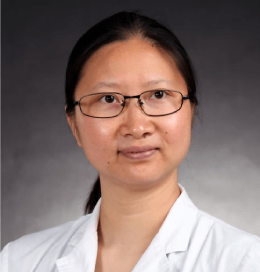
EXPERTISE
Clinical management of pathological scarring, e.g. keloids & hypertrophic scars.
Fundamental explorations in keloid etiology, in particular the mechanobiology mechanisms.
Proposing and applying mechanotherapy in scars, targeting at preventing or reducing scars by mechanical means at molecular, cellular, or tissue levels.
With >60 professional journal article publications focusing on pathological scarring since 2010
EDUCATION
2004/9-2007/7 Peking Union Medical College & Tsinghua University, Ph.D.
1999/9-2002/7 Institute of Traumatology and Orthopedics & Peking University, M.Sc.
1994/9-1999/7 Capital Medical University, M.D.
PROFESSIONAL EXPERIENCE
2019/12 till now Tsinghua University, Associate Professor
2014/8 till now Department of Dermatology, Beijing Tsinghua Changgung Hospital
2013/1-2013/12 Brigham and Women’s Hospital, Harvard Medical School, Postdoc
2009/9-2011/8 Nippon Medical School, Visiting scholar
PUBLICATIONS (selected)
(1) Mechanotherapy: revisiting physical therapy and recruiting mechanobiology for a new era in medicine. Trends Mol Med. 2013;19:555-64.
(2) Endothelial dysfunction and mechanobiology in pathological cutaneous scarring: lessons learned from soft tissue fibrosis. Br J Dermatol. 2017;177:1248-1255.
(3) TGase-Enhanced Microtissue Assembly in 3D-Printed-Template-Scaffold (3D-MAPS) for Large Tissue Defect Reparation. Adv Healthc Mater. 2020;9:e2000531.
(4) Asporin inhibits collagen matrix-mediated intercellular mechanocommunications between fibroblasts during keloid progression. FASEB J. 2021;35:e21705.
(5) GRHL2 regulates keratinocyte EMT-MET dynamics and scar formation during cutaneous wound healing. Cell Death & Disease. 2024;15:748
Abstract submitted for the 5th International Keloid Symposium
Keloids are fibrotic lesions that grow unceasingly and invasively and are driven by local mechanical stimuli. Unlike other fibrotic diseases and normal wound healing, keloids exhibit little transformation of dermal fibroblasts into α-SMA+ myofibroblasts. This study showed that asporin is the most strongly expressed gene in keloids and its gene-ontology terms relate strongly to ECM metabolism/organization. Experiments with human dermal cells (HDFs) showed that asporin overexpression/treatment abrogated the HDF ability to adopt a perpendicular orientation when subjected to stretching tension. It also induced calcification of the surrounding 3D collagen matrix. Asporin overexpression/treatment also prevented the HDFs from remodeling the surrounding 3D collagen matrix, leading to a disorganized network of thick, wavy collagen fibers that resembled keloid collagen architecture. This in turn impaired the ability of the HDFs to contract the collagen matrix. Asporin treatment also made the fibroblasts impervious to the fibrous collagen contraction of α-SMA+ myofibroblasts, which normally activates fibroblasts. Thus, by calcifying collagen, asporin prevents fibroblasts from linearly rearranging the surrounding collagen; this reduces both their mechanosensitivity and mechanosignaling to each other through the collagen network. This blocks fibroblast activation and differentiation into the mature myofibroblasts that efficiently remodel the extracellular matrix. Consequently, the fibroblasts remain immature, highly proliferative, and continue laying down abundant extracellular matrix, causing keloid growth and invasion. Notably, dermal injection of asporin-overexpressing HDFs into murine wounds recapitulated keloid collagen histopathological characteristics. Thus, disrupted interfibroblast mechanocommunication may promote keloid progression. Asporin may be a new diagnostic biomarker and therapeutic target for keloids.










